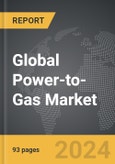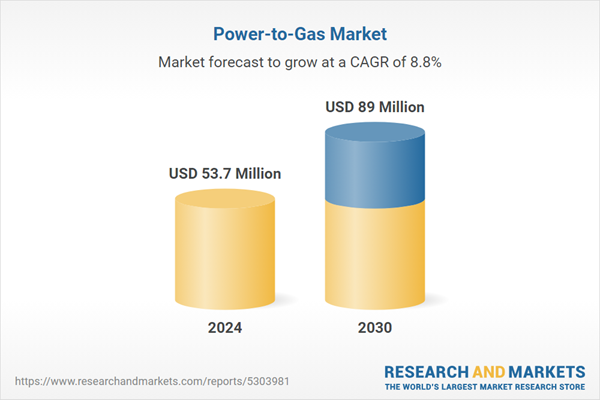Global Power-to-Gas Market - Key Trends & Drivers Summarized
How Is Power-to-Gas Technology Emerging As A Key Player In The Energy Transition?
Power-to-Gas (P2G) technology is rapidly gaining traction as a critical solution in the global energy transition, particularly as nations strive to meet ambitious carbon reduction goals and increase the integration of renewable energy sources into the grid. This innovative process allows for the conversion of surplus renewable energy, such as wind and solar power, into hydrogen or synthetic methane through electrolysis. By converting excess electricity into gas, Power-to-Gas offers an effective method for long-term energy storage and a way to address the intermittency issues associated with renewable energy sources. The growing capacity of wind and solar installations globally has intensified the need for such flexible energy storage solutions, as these renewable sources often generate power when demand is low or in unpredictable bursts. P2G not only helps balance the grid by storing excess energy but also provides a pathway for decarbonizing sectors that are difficult to electrify, such as heavy industry, heating, and transportation. Countries with strong renewable energy mandates, particularly in Europe and parts of Asia, are leading the way in adopting Power-to-Gas technology, recognizing its potential to complement the energy ecosystem and support the shift toward greener alternatives.What Technological Advancements Are Shaping The Power-to-Gas Market?
Technological advancements in electrolyzer efficiency, gas storage, and distribution infrastructure are playing a pivotal role in accelerating the growth of the Power-to-Gas market. One of the key innovations driving this market is the development of more efficient and scalable electrolyzers, such as proton exchange membrane (PEM) electrolyzers, alkaline electrolyzers, and solid oxide electrolyzers. These technologies are becoming more cost-effective, energy-efficient, and capable of operating at larger scales, making the P2G process increasingly viable for widespread adoption. In particular, PEM electrolyzers, which are known for their rapid response times and ability to function efficiently at varying loads, are gaining favor as renewable energy sources such as wind and solar are inherently variable. Furthermore, advancements in hydrogen storage technologies, including high-pressure tanks and underground storage, are helping to overcome one of the key challenges in the Power-to-Gas process - storing large quantities of hydrogen safely and economically. The development of hydrogen transport infrastructure, such as pipelines and fueling stations, is also critical for connecting the production sites to end-users, particularly in industries such as transportation and manufacturing. Additionally, ongoing research into synthetic methane production, which allows for the use of existing natural gas infrastructure, is expanding the range of applications for Power-to-Gas technology, enhancing its potential to play a significant role in global energy systems.How Are Policy Support And Environmental Goals Driving The Adoption Of Power-to-Gas?
Government policies and environmental regulations aimed at reducing greenhouse gas emissions and promoting renewable energy adoption are significant drivers of the Power-to-Gas market. Many countries have set ambitious targets for carbon neutrality, which require a dramatic reduction in emissions across all sectors of the economy. The versatility of Power-to-Gas technology makes it a valuable tool for achieving these goals, particularly in sectors where direct electrification is challenging, such as heavy transportation, steel manufacturing, and chemical production. For instance, hydrogen produced via P2G can be used as a clean fuel for vehicles, reducing the reliance on fossil fuels and helping to decarbonize the transportation sector. In Europe, policies such as the European Green Deal and the Hydrogen Strategy are providing strong support for hydrogen as a cornerstone of future energy systems, with Power-to-Gas technology playing a critical role in producing green hydrogen. Similarly, in countries like Japan and South Korea, government initiatives are promoting hydrogen-based economies, creating a favorable regulatory environment for Power-to-Gas projects. Furthermore, as nations seek to increase their share of renewable energy in the overall energy mix, the ability of P2G to store surplus electricity during periods of low demand and generate renewable gases is seen as an essential solution to stabilize energy systems and improve the resilience of the power grid.What Factors Are Driving The Growth Of The Power-to-Gas Market?
The growth in the Power-to-Gas market is driven by several factors, including the increasing integration of renewable energy sources, advances in hydrogen technology, and growing demand for energy storage solutions. One of the primary drivers is the rising share of renewable energy in the global energy mix, which necessitates more robust solutions for managing excess power generation and addressing grid stability issues. Power-to-Gas offers an innovative way to convert this surplus renewable electricity into storable gas, allowing for long-term energy storage and providing a flexible mechanism to balance supply and demand in the power grid. Additionally, the expanding hydrogen economy is a key factor propelling market growth, as hydrogen produced via electrolysis can be used in a wide range of applications, from transportation to industrial processes, and even in residential heating. As hydrogen fuel cell technology becomes more mainstream, the demand for green hydrogen produced through Power-to-Gas is expected to increase significantly. Moreover, the development of supportive infrastructure, such as hydrogen pipelines, storage facilities, and fueling stations, is facilitating the deployment of P2G projects on a larger scale.Another key growth driver is the shift towards decarbonization, with industries and governments worldwide focusing on reducing carbon emissions across sectors that are hard to electrify. Power-to-Gas provides a viable solution by enabling the production of green hydrogen or synthetic methane, both of which can replace fossil fuels in high-energy sectors like steel production, shipping, and aviation. Furthermore, technological advancements are making Power-to-Gas more cost-effective, as the cost of electrolyzers continues to decrease, and renewable energy becomes cheaper to generate. The increasing emphasis on energy security, especially in regions that are heavily reliant on imported fossil fuels, is also driving the adoption of P2G, as it offers a way to locally produce and store energy, reducing dependence on external energy sources. These factors, combined with favorable regulatory environments and growing investment in hydrogen and renewable energy projects, are expected to drive the Power-to-Gas market's expansion in the coming years.
Report Scope
The report analyzes the Power-to-Gas market, presented in terms of market value (US$ Thousand). The analysis covers the key segments and geographic regions outlined below.- Segments: Technology (Electrolysis, Methanation); Capacity (1000 kW & Above, 100-999 kW, Less than 100 kW); End-Use (Utilities, Commercial, Industrial).
- Geographic Regions/Countries:World; United States; Canada; Japan; China; Europe (France; Germany; Italy; United Kingdom; and Rest of Europe); Asia-Pacific; Rest of World.
Key Insights:
- Market Growth: Understand the significant growth trajectory of the Electrolysis Technology segment, which is expected to reach US$59.8 Million by 2030 with a CAGR of a 9.2%. The Methanation Technology segment is also set to grow at 8% CAGR over the analysis period.
- Regional Analysis: Gain insights into the U.S. market, valued at $15.1 Million in 2024, and China, forecasted to grow at an impressive 8.2% CAGR to reach $13.6 Million by 2030. Discover growth trends in other key regions, including Japan, Canada, Germany, and the Asia-Pacific.
Why You Should Buy This Report:
- Detailed Market Analysis: Access a thorough analysis of the Global Power-to-Gas Market, covering all major geographic regions and market segments.
- Competitive Insights: Get an overview of the competitive landscape, including the market presence of major players across different geographies.
- Future Trends and Drivers: Understand the key trends and drivers shaping the future of the Global Power-to-Gas Market.
- Actionable Insights: Benefit from actionable insights that can help you identify new revenue opportunities and make strategic business decisions.
Key Questions Answered:
- How is the Global Power-to-Gas Market expected to evolve by 2030?
- What are the main drivers and restraints affecting the market?
- Which market segments will grow the most over the forecast period?
- How will market shares for different regions and segments change by 2030?
- Who are the leading players in the market, and what are their prospects?
Report Features:
- Comprehensive Market Data: Independent analysis of annual sales and market forecasts in US$ Million from 2024 to 2030.
- In-Depth Regional Analysis: Detailed insights into key markets, including the U.S., China, Japan, Canada, Europe, Asia-Pacific, Latin America, Middle East, and Africa.
- Company Profiles: Coverage of players such as Aquahydrex, Avacon, Carbotech, Electrochaea, Exytron and more.
- Complimentary Updates: Receive free report updates for one year to keep you informed of the latest market developments.
Some of the 37 companies featured in this Power-to-Gas market report include:
- Aquahydrex
- Avacon
- Carbotech
- Electrochaea
- Exytron
- Fuelcell Energy
- GreenHydrogen
- Hitachi Zosen Inova Etogas
- Hydrogenics
- Ineratec
- ITM Power
- MAN Energy Solutions
- McPhy Energy
- Micropyros
- Nel Hydrogen
- Power-to-gas Hungary
- Siemens
- Socalgas
- ThyssenKrupp
- Uniper
This edition integrates the latest global trade and economic shifts into comprehensive market analysis. Key updates include:
- Tariff and Trade Impact: Insights into global tariff negotiations across 180+ countries, with analysis of supply chain turbulence, sourcing disruptions, and geographic realignment. Special focus on 2025 as a pivotal year for trade tensions, including updated perspectives on the Trump-era tariffs.
- Adjusted Forecasts and Analytics: Revised global and regional market forecasts through 2030, incorporating tariff effects, economic uncertainty, and structural changes in globalization. Includes historical analysis from 2015 to 2023.
- Strategic Market Dynamics: Evaluation of revised market prospects, regional outlooks, and key economic indicators such as population and urbanization trends.
- Innovation & Technology Trends: Latest developments in product and process innovation, emerging technologies, and key industry drivers shaping the competitive landscape.
- Competitive Intelligence: Updated global market share estimates for 2025, competitive positioning of major players (Strong/Active/Niche/Trivial), and refined focus on leading global brands and core players.
- Expert Insight & Commentary: Strategic analysis from economists, trade experts, and domain specialists to contextualize market shifts and identify emerging opportunities.
Table of Contents
Companies Mentioned (Partial List)
A selection of companies mentioned in this report includes, but is not limited to:
- Aquahydrex
- Avacon
- Carbotech
- Electrochaea
- Exytron
- Fuelcell Energy
- GreenHydrogen
- Hitachi Zosen Inova Etogas
- Hydrogenics
- Ineratec
- ITM Power
- MAN Energy Solutions
- McPhy Energy
- Micropyros
- Nel Hydrogen
- Power-to-gas Hungary
- Siemens
- Socalgas
- ThyssenKrupp
- Uniper
Table Information
| Report Attribute | Details |
|---|---|
| No. of Pages | 167 |
| Published | December 2025 |
| Forecast Period | 2024 - 2030 |
| Estimated Market Value ( USD | $ 53.7 Million |
| Forecasted Market Value ( USD | $ 89 Million |
| Compound Annual Growth Rate | 8.8% |
| Regions Covered | Global |









